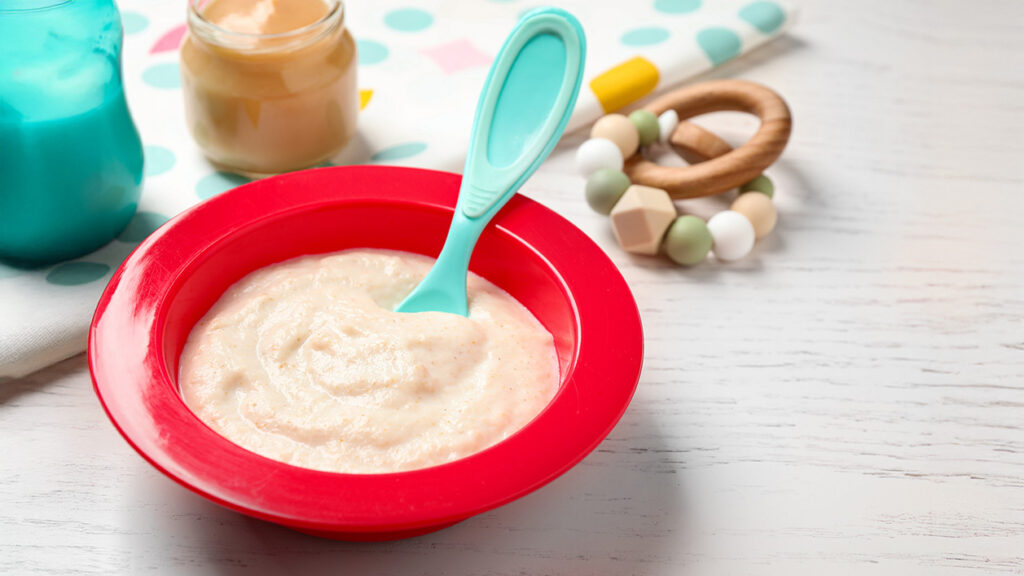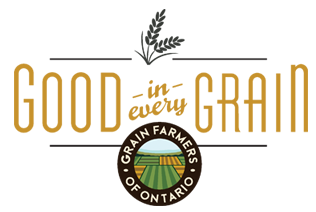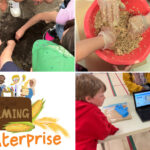Grains for baby

Written by: Michelle Jaelin, Registered Dietitian
Are grains healthy for my baby? Yes, they are! This question is commonly asked by new parents, and a topic I can address as a registered dietitian and new mom to twins.
When it comes time to introduce solids at around 6 months of age, one of the first foods often introduced to baby are grain foods. Grains provide essential energy and nutrients for their rapid growth and development. Let’s delve into some of the healthy grain options for your baby.
Oats: a top starter cereal
Oats have a mild flavour and smooth texture when cooked, making them a popular first grain. They are a good source of fibre, which aids in digestion and helps prevent constipation, a common concern when introducing solids. Oats also contain iron, important for healthy blood development, and zinc, which supports the immune system.
How to serve: Offer iron-fortified infant oat cereal or finely ground, plain cooked oatmeal mixed with breast milk, formula, or pureed fruit or vegetables. Cool to a safe temperature before serving.
Introducing wheat to your baby
Wheat can be introduced to baby as soon as they are ready to start solid foods, again at around 6 months of age. As a food considered to be a priority food allergen, current recommendations advise against delaying the introduction of common allergens like wheat beyond this timeframe, as early introduction may help prevent the development of allergies.
Wheat, especially whole wheat varieties, offers several important nutrients for your baby’s growth and development:
- Carbohydrates: Provide essential energy.
- Fibre: Aids in healthy digestion and promotes gut health.
- Iron: For healthy blood development; many infant wheat cereals are fortified with iron.
- B vitamins (including folate, thiamin, riboflavin, niacin): Support various bodily functions, including cell growth and energy metabolism.
- Antioxidants: Help protect cells from damage.
- Protein: Contributes to building and repairing tissues.
How to safely introduce wheat:
The key is to offer wheat in a texture that is appropriate for your baby’s age and developmental stage to minimize the risk of choking.
6+ months
- Iron-fortified wheat baby cereal: Similar to oat cereal, this is a safe first way to introduce wheat. Mix it with breast milk or formula to a thin, smooth consistency and feed with a spoon. Ensure it’s a single-grain cereal initially.
- Wheat porridge (Cream of Wheat, Farina): Cooked until smooth with breast milk or formula.
- Lightly toasted bread: Cut into strips or small, manageable pieces for baby to gnaw on. Avoid overly soft or gummy bread that can clump in the mouth. Crustier breads are recommended more as they may be less likely to break off in large pieces.
- Pancakes: Made with wheat flour, offered in small, soft pieces.
9+ months:
Continue with the above, gradually increasing texture as tolerated.
- Cooked wheat berries: Ensure they are cooked until very soft and slightly mashed with a fork to prevent scattering in the mouth.
- Pasta: Cooked until very soft and cut into small, bite-sized pieces. For better nutrition, go for whole wheat pasta.
12+ months:
- Offer a wider variety of wheat-containing foods in age-appropriate textures.
What about grain corn cereal?
Grain corn prepared as cooked cornmeal, often known as grits or polenta. It can be introduced as a smooth, scoopable food for baby. Make sure to prepare it so it’s not too thick.
Barley for older babies
Barley, particularly pot barley, offers a good source of fibre and selenium. However, its slightly chewy texture makes it more suitable for babies who are a bit older and have developed more chewing skills, typically around 7-9 months.
- How to serve: Cook pot barley until very soft. Ensure it’s thoroughly mashed or pureed for younger babies. As they get older, you can offer it in a slightly thicker consistency.
Important considerations for introducing grains
- Introduce one grain at a time: Wait a few days between introducing new grains to monitor for any potential allergic reactions or sensitivities
- Avoid added sugars and salt: Offer plain cooked grains without any added sweeteners or salt to protect your baby’s developing taste preferences and kidneys.
- Focus on whole grains: Opt for whole grain varieties like oats, pot barley and whole wheat over refined options like white rice, as they offer more nutrients and fibre.
- Texture progression: Start with smooth purees and gradually introduce thicker textures and softer lumps as your baby develops oral motor skills.
- Consult with your pediatrician or family doctor: Discuss introducing solid foods, including grains, with your baby’s physician. They can provide personalized guidance based on your baby’s individual needs and development.
Introducing healthy grains is an important step in your baby’s nutritional journey. By offering a variety of these nutrient-rich options, you can help lay the foundation for a lifetime of healthy eating habits. Be sure to check out Good in Every Meal for many grain recipes that can be adapted to fit the needs of babies and toddlers!
Michelle Jaelin (she/they) is a nutrition communicator and registered dietitian. Her favourite grain foods are pizza, chocolate peanut butter overnight oats and tofu stir fry on wheat noodles. She resides in Hamilton, ON with her spouse, twins and rescue dog. Find her online here:
Instagram @michellejaelin X @michellejaelin TikTok @michellejaelin Facebook @NutritionArtistRD YouTube: @michellejaelin Website: michellejaelin.com



